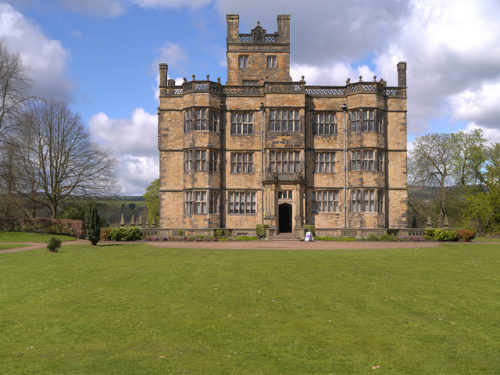UNITED KINGDOM — An unusually prolonged bout of hot weather along with developments in aerial technology have had an unexpected benefit for those interested in archaeology. The desiccation of the landscape has led to the discovery of a number of ancient earthworks.
The dry weather has created ideal conditions for crop marks to show in the soil above old settlements. Most of these settlements were surrounded by fortifications, including drainage ditches, which have long since been filled in, but the difference in soil entails that they retain moisture. In the dry weather, therefore, plants growing on top of these in-filled ditches remain green, while those in surrounding areas dry off, creating clearly-defined indications of the location of early earthworks.

Iron Age Hill Fort Gaer Fawr [Jasperfforde].
The crop that grows in the archaeological features is getting a tiny bit more moisture than the surrounding crop so it looks greener and more vibrant,” he explains. “The result is that you see an imprint or a “footprint” of the monument on the top of the crops. We haven’t had drought conditions like this in Ireland since 1976, and back then there were no drones and very few people looked at archaeology from the air. Nowadays, aerial photography and imaging is a very significant part of archaeological investigation.
In Wales, Toby Driver, the aerial commissioner for the Royal Commission for the Ancient and Historical Monuments of Wales was able to spot the outlines of the Iron Age fort of Gaer Fawr, along with Roman or Iron Age settlements. These sites were already known, but Gaer Fawr has not been seen for thirty years and the aerial commission has also made new discoveries: a prehistoric or Roman farm near Newport, and a small Roman fort near Magor. The fortifications of the hillfort of Cross Oak at Talybont on Usk have also been revealed.
There are currently no plans to excavate. So many new features have been revealed this summer that the priority at present remains that of mapping the landscape while the hot weather lasts.
“It’s like a painting that comes out into the field scapes,” describes archaeologist Louise Barker of the Wales Royal Commission to Wired magazine.
Coflein, the online database of the National Monuments’ Record of Wales, has added sites which are only visible in the dry weather. Driver told Fox News:
“The Royal Commission is the national body for the survey and record of the historic environment in Wales. The urgent work is now: taking the air photos before the rain washes away the drought. The most important discoveries are then circulated quickly to experts in Wales for their opinion, while the new photographs are carefully organized and permanently archived. Then we have several months of work ahead of us recording the new sites, mapping the most complex archaeological monuments and finally publishing the new finds at our online database www.coflein.gov.uk or in the popular and academic press.” (see map).
It’s not just Wales that is benefiting from the recent heat-related revelations. Ireland, too, has seen the discovery of previously unknown monuments, including a henge only 1 km from the megalithic site of Newgrange and dating from an estimated 5000 years ago. Murphy discovered this landmark while flying a drone in the Boyne Valley. “We didn’t initially know exactly what it was. but we suspected it was a henge or enclosure. There are several in the immediate vicinity. As soon as we landed, we sent some images to some archaeologists, and they were immediately very excited about what we had discovered,” he told Lonely Planet.
An archaeologist at the University College Dublin has reportedly described this as ‘a once in a lifetime find’ and that they are ‘over the moon.’
The monument consists of a ring of double ditches plus a causeway with pits or post-holes around its edge and an entrance, Murphy says.
This discovery is the latest in a series of recently-discovered monuments in a 1.6 km stretch of County Meath (it is in fact the seventh) making this part of ancient Ireland exceptionally rich in earthworks and thus of interest to archaeologists and Pagans alike.
In England, the outlines of the Roman town of Venta Icenorum near Norwich, which was already known, have re-appeared, enabling aerial archaeologists to undertake further research on it. This landscape, like County Meath, is also rich in ancient sites: including Arminghall Henge, a Neolithic ceremonial monument close to the River Yare which may date to c. 3000 BC. The remains of many barrows or burial mounds are also found near this site and may have been two thousand years old by the time the Romans arrived here.
In the later part of the Iron Age (c. 700 B.C.E. – 43 A.D.), Venta seems to have become a major centre for the Eceni (or Iceni) tribe: the home of warrior leader Boudicca. The Roman town, built after her rebellion, includes a 3rd century temple complex – it isn’t known to whom the temple is dedicated, but archaeological investigations in the 1970s found a bronze plaque featuring the figure of Mercury.

Gawthorpe Hall [David Dixon].
The U.K. is not known for its hot weather and it is only a matter of time before its customary rainfall once again conceals all traces of the ancient landscape and other past land markings. Driver said with regard to his work in Wales: ‘It’s a race against time now to find out the significance of this new discovery. Those marks will probably only be there for another two-and-a-half weeks or so.’ It is to be hoped that archaeologists in the U.K. make the most of this hot spell and that any further discoveries are quickly logged.
The Wild Hunt is not responsible for links to external content.
To join a conversation on this post:
Visit our The Wild Hunt subreddit! Point your favorite browser to https://www.reddit.com/r/The_Wild_Hunt_News/, then click “JOIN”. Make sure to click the bell, too, to be notified of new articles posted to our subreddit.